Inherent and Local Magnetic Field Structures in Jets from Active Galactic Nuclei
Abstract
1. Introduction
1.1. Background
1.2. Viewing Angles in the Rest Frame of the Jet and Observer
2. AGN Jets and Helical/Toroidal Magnetic Fields
2.1. Theoretical Expectations
2.2. Faraday Rotation Gradients
2.3. Global Patterns in the B-Fields and Currents of AGN Jets
2.4. What about Other Explanations for Observed Transverse RM Gradients?
2.5. Helical vs. Toroidal Fields
2.6. The Initial Field That Is Wound Up—Dipolar or Quadrupolar?
3. Characteristic Magnetic Field Structures of AGN Jets—Global or Local Origin?
3.1. Polarization Structures
3.2. Limb Brightening
4. The Role of Circular Polarization in Determining the Full Three-Dimensional B-Field Structure
5. Summary
Funding
Acknowledgments
Conflicts of Interest
References
- Kellermann, K.I.; Sramek, R.; Schmidt, M.; Shaffer, D.B.; Green, R. VLA observations of objects in the Palomar Bright Quasar Survey. Astron. J 1989, 98, 1195–1207. [Google Scholar] [CrossRef]
- Lister, M.L.; Homan, D.C. MOJAVE: Monitoring of Jets in Active Galactic Nuclei with VLBA Experiments. I. First-Epoch 15 GHz Linear Polarization Images. Astron. J 2005, 130, 1389–1417. [Google Scholar] [CrossRef]
- Pacholczyk, A.G. Radio Astrophysics; W. H. Freeman: San Franciso, CA, USA, 1970. [Google Scholar]
- Wardle, J.F.C. The Variable Rotation Measure Distribution in 3C 273 on Parsec Scales. Galaxies 2018, 6, 5. [Google Scholar] [CrossRef]
- Blandford, R.D.; Königl, A. Relativistic jets as compact radio sources. Astrophys. J. 1979, 232, 34–48. [Google Scholar] [CrossRef]
- Janssen, M.; Falcke, H.; Kadler, M.; Ros, E.; Wielgus, M.; Akiyama, K.; Baloković, M.; Blackburn, L.; Bouman, K.L.; Chael, A.; et al. Event Horizon Telescope observations of the jet launching and collimation zone in Centaurus A. Nat. Astron. 2021, in press. [Google Scholar] [CrossRef]
- The Event Horizon Telescope Collaboration. First M87 Event Horizon Telescope Results. I. The Shadow of the Supermassive Black Hole. Astrophys. J. Lett. 2019, 875, L1–L17. [Google Scholar] [CrossRef]
- Lister, M.L.; Homan, D.C.; Hovatta, T.; Kellermann, K.I.; Kiehlmann, S.; Kovalev, Y.Y.; Max-Boerbeck, W.; Pushkarev, A.B.; Readhead, A.C.S.; Ros, E.; et al. Mojave XVII. Jet kinematics and parent population properies of relativistically beamed radio-loud blazars. Astrophys. J. 2019, 874, 43–61. [Google Scholar] [CrossRef]
- Blandford, R.D.; Payne, D.G. Hydromagnetic flows from accretion disks and the production of radio jets. Mon. Not. R. Astron. Soc. 1982, 199, 883–903. [Google Scholar] [CrossRef]
- Blandford, R.D.; Znajek, R.L. Electromagnetic extraction of energy from Kerr black holes. Mon. Not. R. Astron. Soc. 1977, 179, 433–456. [Google Scholar] [CrossRef]
- Nakamura, M.; Uchida, Y.; Hirose, S. Production of wiggled structure of AGN radio jets in the sweeping magnetic twist mechanism. New Astron. 2001, 6, 61–78. [Google Scholar] [CrossRef]
- Lovelace, R.V.E.; Li, H.; Koldoba, A.V.; Ustyugova, G.V.; Romanova, M.M. Poynting Jets from Accretion Disks. Astrophys. J. 2002, 572, 445–455. [Google Scholar] [CrossRef]
- Tchekhovskoy, A.; Bromberg, O. Three-dimensional relativistic MHD simulations of active galactic nuclei jets: Magnetic kink instability and Fanaroff-Riley dichotomy. Mon. Not. R. Astron. Soc. 2016, 461, L46–L50. [Google Scholar] [CrossRef]
- Barniol Duran, R.; Tchekhovskoy, A.; Giannios, D. Simulations of AGN jets: Magnetic kink instability versus conical shocks. Mon. Not. R. Astron. Soc. 2017, 469, 4957–4978. [Google Scholar] [CrossRef]
- Zamaninasab, M.; Clausen-Brown, E.; Savolainen, T.; Tchekhovskoy, A. Dynamically important magnetic fields near accreting supermassive black holes. Nature 2014, 510, 126–128. [Google Scholar] [CrossRef]
- Tchekhovskoy, A.; Narayan, R.; McKinney, J.C. Efficient generation of jets from magnetically arrested accretion on a rapidly spinning black hole. Mon. Not. R. Astron. Soc. 2011, 418, L79–L83. [Google Scholar] [CrossRef]
- McKinney, J.C.; Tchekhovskoy, A.; Blandford, R.D. General relativistic magnetohydrodynamic simulations of magnetically choked accretion flows around black holes. Mon. Not. R. Astron. Soc. 2012, 423, 3083–3117. [Google Scholar] [CrossRef]
- Contopoulos, I.; Christodoulou, D.; Kazanas, D.; Gabuzda, D.C. The Invariant Twist of Magnetic Fields in the Relativistic Jets of Active Galactic Nuclei. Astrophys. J. 2009, 702, L148–L152. [Google Scholar] [CrossRef]
- Christodoulou, D.; Gabuzda, D.; Knuettel, S.; Contopoulos, I.; Kazanas, D.; Coughlan, C. Dominance of outflowing electric currents on decaparsec to kiloparsec scales in extragalactic jets. Astron. Astrophys. 2016, 591, 61–71. [Google Scholar] [CrossRef]
- Marscher, A.P.; Jorstad, S.G. Frequency and Time Dependence of Linear Polarization in Turbulent Jets of Blazars. Galaxies 2021, 9, 27. [Google Scholar] [CrossRef]
- O’Sullivan, S.P.; Brown, S.; Robishaw, T.; Schnitzeler, D.H.F.M.; McClure-Griffiths, N.M.; Feain, I.J.; Taylor, A.R.; Gaensler, B.M.; Landecker, T.L.; Harvey-Smith, L.; et al. Complex Faraday depth structure of active galactic nuclei as revealed by broad-band radio polarimetry. Mon. Not. R. Astron. Soc. 2012, 421, 3300–3315. [Google Scholar] [CrossRef]
- Perley, R.A.; Bridle, A.H.; Willis, A.G. High-resolution VLA observations of the radio jet in NGC 6251. Astrophys. J. Suppl. 1984, 54, 291–334. [Google Scholar] [CrossRef]
- Blandford, R.D. Astrophysical Jets; Cambridge University Press: Cambridge, UK, 1993; p. 26. [Google Scholar]
- Asada, K.; Inoue, M.; Uchida, Y.; Kameno, S.; Fujisawa, K.; Iguchi, S.; Mutoh, M. A Helical Magnetic Field in the Jet of 3C 273. Publ. Astron. Soc. Jpn. 2002, 54, L39–L43. [Google Scholar] [CrossRef]
- Gabuzda, D.C.; Nagle, M.; Roche, N. The jets of AGN as giant coaxial cables. Astron. Astrophys. 2018, 612, 67–78. [Google Scholar] [CrossRef]
- Knuettel, S.; Gabuzda, D.C.; O’Sullivan, S.P. Evidence for Toroidal B-Field Components in AGN Jets on Kiloparsec Scales. Galaxies 2017, 5, 61. [Google Scholar] [CrossRef]
- Knuettel, S. Evolution of the Magnetic Field Structure in the Jet Outflows from Active Galaxies. Ph.D. Thesis, University College Cork, Cork, Ireland, 2020. [Google Scholar]
- Taylor, G.B.; Zavala, R.T. Are There Rotation Measure Gradients Across Active Galactic Nuclei Jets? Astrophys. J. Lett. 2010, 722, L183–L187. [Google Scholar] [CrossRef]
- Mahmud, M.; Coughlan, C.P.; Murphy, E.; Gabuzda, D.C.; Hallahan, D.R. Connecting magnetic towers with Faraday rotation gradients in active galactic nuclei jets. Mon. Not. R. Astron. Soc. 2013, 431, 695–709. [Google Scholar] [CrossRef]
- Zavala, R.T.; Taylor, G.B. Time-Variable Faraday Rotation Measures of 3C 273 and 3C 279. Astrophys. J. 2001, 550, L147–L150. [Google Scholar] [CrossRef]
- Asada, K.; Inoue, M.; Kameno, S.; Nagai, H. Time Variation of the Rotation Measure Gradient in the 3C 273 Jet. Astrophys. J. 2008, 675, 79–82. [Google Scholar] [CrossRef]
- Mahmud, M.; Gabuzda, D.C.; Bezrukovs, V. Surprising evolution of the parsec-scale Faraday Rotation gradients in the jet of the BL Lac object B1803+784. Mon. Not. R. Astron. Soc. 2009, 400, 2–12. [Google Scholar] [CrossRef]
- Gómez, J.L.; Roca-Sogorb, M.; Agudo, I.; Marscher, A.P.; Jorstad, S.G. On the Source of Faraday Rotation in the Jet of the Radio Galaxy 3C 120. Astrophys. J. 2011, 733, 11–22. [Google Scholar] [CrossRef]
- Hovatta, T.; Lister, M.L.; Aller, M.F.; Aller, H.D.; Homan, D.C.; Kovalev, Y.Y.; Pushkarev, A.B.; Savolainen, T. MOJAVE: Monitoring of Jets in Active Galactic Nuclei with VLBA Experiments. VIII. Faraday Rotation in Parsec-scale AGN Jets. Astron. J 2012, 144, 105–138. [Google Scholar] [CrossRef]
- Lisakov, M.M.; Kravchenko, E.V.; Pushkarev, A.B.; Kovalev, Y.Y.; Savolainen, T.K.; Lister, M.L. An Oversized Magnetic Sheath Wrapping around the Parsec-scale Jet in 3C 273. Astrophys. J. 2021, 910, 35–42. [Google Scholar] [CrossRef]
- Kravchenko, E.V.; Kovalev, Y.Y.; Sokolovsky, K.V. Parsec-scale Faraday rotation and polarization of 20 active galactic nuclei jets. Mon. Not. R. Astron. Soc. 2017, 467, 83–101. [Google Scholar] [CrossRef][Green Version]
- Plavin, A.; Kovalev, Y.Y.; Kovalev, Y.A.; Troitsky, S. Observational Evidence for the Origin of High-energy Neutrinos in Parsec-scale Nuclei of Radio-bright Active Galaxies. Astrophys. J. 2020, 894, 101–113. [Google Scholar] [CrossRef]
- Plavin, A.; Kovalev, Y.Y.; Kovalev, Y.A.; Troitsky, S. Directional Association of TeV to PeV Astrophysical Neutrinos with Radio Blazars. Astrophys. J. 2021, 908, 157–166. [Google Scholar] [CrossRef]
- Hovatta, T.; Lindfors, E.; Kiehlmann, S.; Max-Moerbeck, W.; Hodges, M.; Liodakis, I.; Lähteemäki, A.; Pearson, T.J.; Readhead, A.C.S.; Reeves, R.A.; et al. Association of IceCube neutrinos with radio sources observed at Owens Valley and Metsähovi Radio Observatories. Astron. Astrophys. 2021, 650, 83–99. [Google Scholar] [CrossRef]
- Gabuzda, D.C.; Roche, N.; Kirwan, A.; Knuettel, S.; Nagle, M.; Houston, C. Parsec scale Faraday-rotation structure across the jets of nine active galactic nuclei. Astron. Astrophys. 2017, 472, 1792–1801. [Google Scholar] [CrossRef]
- Murphy, E.; Cawthorne, T.V.; Gabuzda, D.C. Analysing the transverse structure of the relativistic jets of active galactic nuclei. Mon. Not. R. Astron. Soc. 2013, 430, 1504–1515. [Google Scholar] [CrossRef]
- McKinney, J.C.; Blandford, R.D. Stability of relativistic jets from rotating, accreting black holes via fully three-dimensional magnetohydrodynamic simulations. Mon. Not. R. Astron. Soc. 2009, 394, L126–L130. [Google Scholar] [CrossRef]
- Gabuzda, D.C.; Knuettel, S.; Bonafede, A. Evidence for a toroidal magnetic-field component in 5C 4.114 on kiloparsec scales. Astron. Astrophys. 2015, 583, 96–100. [Google Scholar] [CrossRef]
- Knuettel, S.; O’Sullivan, S.P.; Curiel, S.; Emonts, B.H.C. The magnetic field strength of the Faraday screen surrounding the radio galaxy Coma A. Mon. Not. R. Astron. Soc. 2019, 482, 4606–4616. [Google Scholar] [CrossRef]
- Lyutikov, M.; Pariev, V.I.; Gabuzda, D.C. Polarization and structure of relativistic parsec-scale AGN jets. Mon. Not. R. Astron. Soc. 2005, 360, 869–891. [Google Scholar] [CrossRef]
- Gabuzda, D.C. Parsec-Scale Jets in Active Galactic Nuclei. In The Formation and Disruption of Black Hole Jets; Astrophysics and Space Science Library; Springer: Cham, Switzerland, 2015; Volume 414, pp. 117–142. [Google Scholar]
- Pushkarev, A.B.; Gabuzda, D.C.; Vetukhnovskaya, Y.N.; Yakimov, V.E. Spine-sheath polarization structures in four active galactic nuclei jets. Mon. Not. R. Astron. Soc. 2005, 356, 859–871. [Google Scholar] [CrossRef]
- Gabuzda, D.C.; Pushkarev, A.B.; Cawthorne, T.V. Analysis of λ = 6 cm VLBI polarization observations of a complete sample of northern BL Lacertae objects. Mon. Not. R. Astron. Soc. 2000, 319, 1109–1124. [Google Scholar] [CrossRef]
- Healy, F. Multi-Epoch 18–22 cm VLBA Observations of Several BL Lac Objects. Master’s Thesis, University College Cork, Cork, Ireland, 2013. [Google Scholar]
- Laing, R. A model for the magnetic-field structure in extended radio sources. Mon. Not. R. Astron. Soc. 1980, 193, 439–449. [Google Scholar] [CrossRef]
- Hughes, P.A.; Aller, H.D.; Aller, M.A. Polarized Radio Outbursts in Bl-Lacertae-Part Two-the Flux and Polarization of a Piston-Driven Shock. Astrophys. J. 1985, 298, 301–315. [Google Scholar] [CrossRef]
- Hughes, P.A.; Aller, H.D.; Aller, M.A. Synchrotron Emission from Shocked Relativistic Jets. II. A Model for the Centimeter Wave Band Quiescent and Burst Emission from BL Lacertae. Astrophys. J. 1989, 341, 68–79. [Google Scholar] [CrossRef]
- Marscher, A.P.; Gear, W.K. Models for high-frequency radio outbursts in extragalactic sources, with application to the early 1983 millimeter-to-infrared flare of 3C 273. Astrophys. J. 1985, 298, 114–127. [Google Scholar] [CrossRef]
- Laing, R.A.; Bridle, A.H. Systematic properties of decelerating relativistic jets in low-luminosity radio galaxies. Mon. Not. R. Astron. Soc. 2014, 437, 3405–3441. [Google Scholar] [CrossRef]
- Clausen-Brown, E.; Lyutikov, M.; Kharb, P. Signatures of large-scale magnetic fields in active galactic nuclei jets: Transverse asymmetries. Mon. Not. R. Astron. Soc. 2011, 415, 2081–2092. [Google Scholar] [CrossRef]
- Attridge, J.M.; Roberts, D.H.; Wardle, J.F.C. Radio Jet-Ambient Medium Interactions on Parsec Scales in the Blazar 1055+018. Astrophys. J. Lett. 1999, 518, L87–L90. [Google Scholar] [CrossRef]
- Sironi, L.; Rowan, M.E.; Narayan, R. Reconnection-driven Particle Acceleration in Relativistic Shear Flows. Astrophys. J. Lett. 2021, 907, L44–L49. [Google Scholar] [CrossRef]
- Kramer, J.A.; MacDonald, N.R. Ray-Tracing in Relativistic Jet Simulations: A Polarimetric Study of Magnetic Field Morphology and Electron Scaling Relations. Astron. Astrophys. 2021, submitted. [Google Scholar]
- Takahashi, K.; Toma, K.; Kino, M.; Nakamura, M.; Hada, K. Fast-spinning Black Holes Inferred from Symmetrically Limb-brightened Radio Jets. Astrophys. J. 2018, 868, 82–101. [Google Scholar] [CrossRef]
- Walker, R.C.; Hardee, P.E.; Davies, F.B.; Ly, C.; Junor, W. The Structure and Dynamics of the Subparsec Jet in M87 Based on 50 VLBA Observations over 17 Years at 43 GHz. Astrophys. J. 2018, 855, 128–163. [Google Scholar] [CrossRef]
- Giovannini, G.; Savolainen, T.; Orienti, M.; Nakamura, M.; Nagai, H.; Kino, M.; Giroletti, M.; Hada, K.; Bruni, G.; Kovalev, Y.Y.; et al. A wide and collimated radio jet in 3C84 on the scale of a few hundred gravitational radii. Nat. Astron. 2018, 2, 472–477. [Google Scholar] [CrossRef]
- Giroletti, M.; Giovannini, G.; Feretti, L.; Cotton, W.D.; Edwards, P.G.; Lara, L.; Marscher, A.P.; Mattox, J.R.; Piner, B.G.; Venturi, T. Parsec-Scale Properties of Markarian 501. Astrophys. J. 2004, 600, 127–140. [Google Scholar] [CrossRef]
- Giroletti, M.; Giovannini, G.; Cotton, W.D.; Taylor, G.B.; P/’erez-Torres, M.A.; Chiaberge, M.; Edwards, P.G. The jet of Markarian 501 from millions of Schwarzschild radii down to a few hundreds. Astron. Astrophys. 2008, 488, 905–914. [Google Scholar] [CrossRef]
- Nakamura, M.; Asada, K.; Hada, K.; Pu, H.-Y.; Noble, S.; Tseng, C.; Toma, K.; Kino, M.; Nagai, H.; Takahashi, K.; et al. Parabolic Jets from the Spinning Black Hole in M87. Astrophys. J. 2018, 868, 146–173. [Google Scholar] [CrossRef]
- Chatterjee, K.; Liska, M.; Tchekhovskoy, A.; Markoff, S.B. Accelerating AGN jets to parsec scales using general relativistic MHD simulations. Mon. Not. R. Astron. Soc. 2019, 490, 2200–2218. [Google Scholar] [CrossRef]
- Huang, L.; Pan, Z.; Yu, C. Toward a Full MHD Jet Model of Spinning Black Holes. II. Kinematics and Application to the M87 Jet. Astrophys. J. 2020, 894, 45–56. [Google Scholar] [CrossRef]
- Doi, A.; Hada, K.; Kino, M.; Wajima, K.; Nakahara, S. A Recollimation Shock in a Stationary Jet Feature with Limb-brightening in the Gamma-Ray-emitting Narrow-line Seyfert 1 Galaxy 1H 0323+342. Astrophys. J. Lett. 2018, 857, L6–L11. [Google Scholar] [CrossRef]
- Gabuzda, D.C.; Murray, É.; Cronin, P.J. Helical magnetic fields associated with the relativistic jets of four BL Lac objects. Astrophys. J. 2004, 351, L89–L93. [Google Scholar] [CrossRef]
- Croke, S.M.; O’Sullivan, S.P.; Gabuzda, D.C. The parsec-scale distributions of intensity, linear polarization and Faraday rotation in the core and jet of Mrk501 at 8.4–1.6 GHz. Mon. Not. R. Astron. Soc. 2010, 402, 259–270. [Google Scholar] [CrossRef]
- Kovalev, Y.Y.; Lobanov, A.P.; Pushkarev, A.B.; Zensus, J.A. Opacity in compact extragalactic radio sources and its effect on astrophysical and astrometric studies. Astron. Astrophys. 2008, 483, 759–768. [Google Scholar] [CrossRef]
- O’Sullivan, S.P.; Gabuzda, D.C. Magnetic field strength and spectral distribution of six parsec-scale active galactic nuclei jets. Mon. Not. R. Astron. Soc. 2009, 400, 26–42. [Google Scholar] [CrossRef]
- Sokolovsky, K.V.; Kovalev, Y.Y.; Pushkarev, A.B.; Lobanov, A.P. A VLBA survey of the core shift effect in AGN jets. I. Evidence of dominating synchrotron opacity. Astron. Astrophys. 2011, 532, 38–68. [Google Scholar] [CrossRef]
- Pushkarev, A.B.; Hovatta, T.; Kovalev, Y.Y.; Lister, M.L.; Lobanov, A.P.; Savolainen, T.; Zensus, J.A. MOJAVE: Monitoring of Jets in Active galactic nuclei with VLBA Experiments. IX. Nuclear opacity. Astron. Astrophys. 2012, 545, 113–127. [Google Scholar] [CrossRef]
- Homan, D.C.; Lister, M.L. MOJAVE: Monitoring of Jets in Active Galactic Nuclei with VLBA Experiments. II. First-Epoch 15 GHz Circular Polarization Results. Astron. J 2006, 131, 1262–1279. [Google Scholar] [CrossRef]
- Homan, D.C.; Wardle, J.F.C. High Levels of Circularly Polarized Emission from the Radio Jet in NGC 1275 (3C 84). Astrophys. J. 2004, 602, L13–L16. [Google Scholar] [CrossRef]
- Vitrishchak, V.M.; Gabuzda, D.C.; Algaba, J.C.; Rastorgueva, E.A.; O’Sullivan, S.P.; O’Dowd, A. The 15–43 GHz parsec-scale circular polarization of 41 active galactic nuclei. Mon. Not. R. Astron. Soc. 2008, 391, 124–135. [Google Scholar] [CrossRef]
- Jones, T.W.; O’Dell, S.L. Transfer of polarized radiation in self-absorbed synchrotron sources. I. Results for a homogeneous source. Astrophys. J. 1977, 214, 522–539. [Google Scholar] [CrossRef]
- Gabuzda, D.C.; Vitrishchak, V.M.; Mahmud, M.; O’Sullivan, S.P. Radio circular polarization produced in helical magnetic fields in eight active galactic nuclei. Mon. Not. R. Astron. Soc. 2008, 384, 1003–1014. [Google Scholar] [CrossRef]
- Wardle, J.F.C.; Homan, D.A. The nature of jets: Evidence from circular polarization observations. In Particles and Fields in Radio Galaxies; Astron. Soc. Pac.: San Francisco, CA, USA, 2001; pp. 152–163. [Google Scholar]
- Ensslin, T.A. Does circular polarisation reveal the rotation of quasar engines? Astron. Astrophys. 2003, 401, 499–504. [Google Scholar] [CrossRef]
- Homan, D.C. Inverse Depolarization: A Potential Probe of Internal Faraday Rotation and Helical Magnetic Fields in Extragalactic Radio Jets. Astrophys. J. 2012, 757, L24–L28. [Google Scholar] [CrossRef]
- Gabuzda, D.C. Determining the Jet Poloidal B Field and Black-Hole Rotation Directions in AGNs. Galaxies 2018, 6, 9. [Google Scholar] [CrossRef]
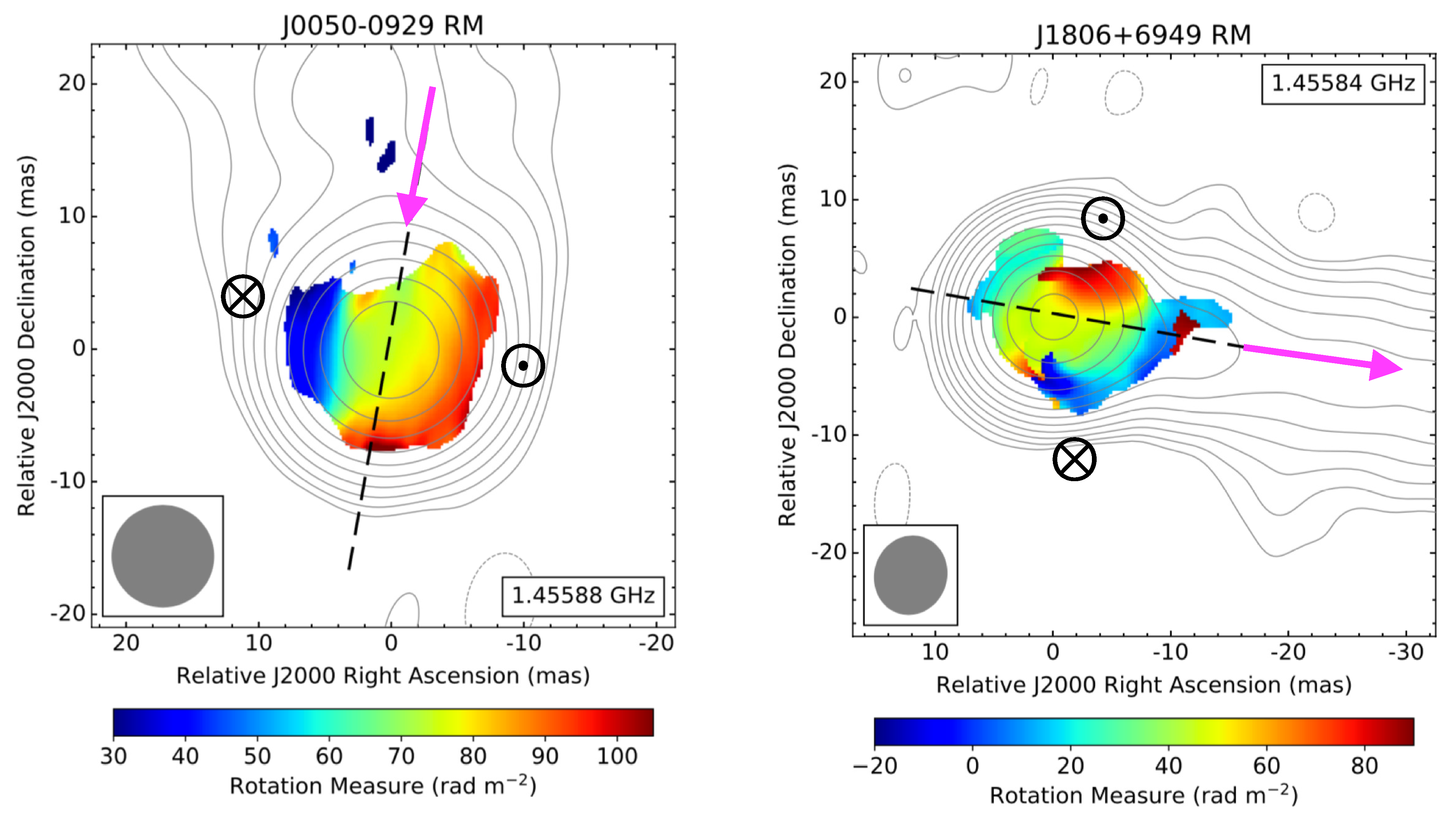

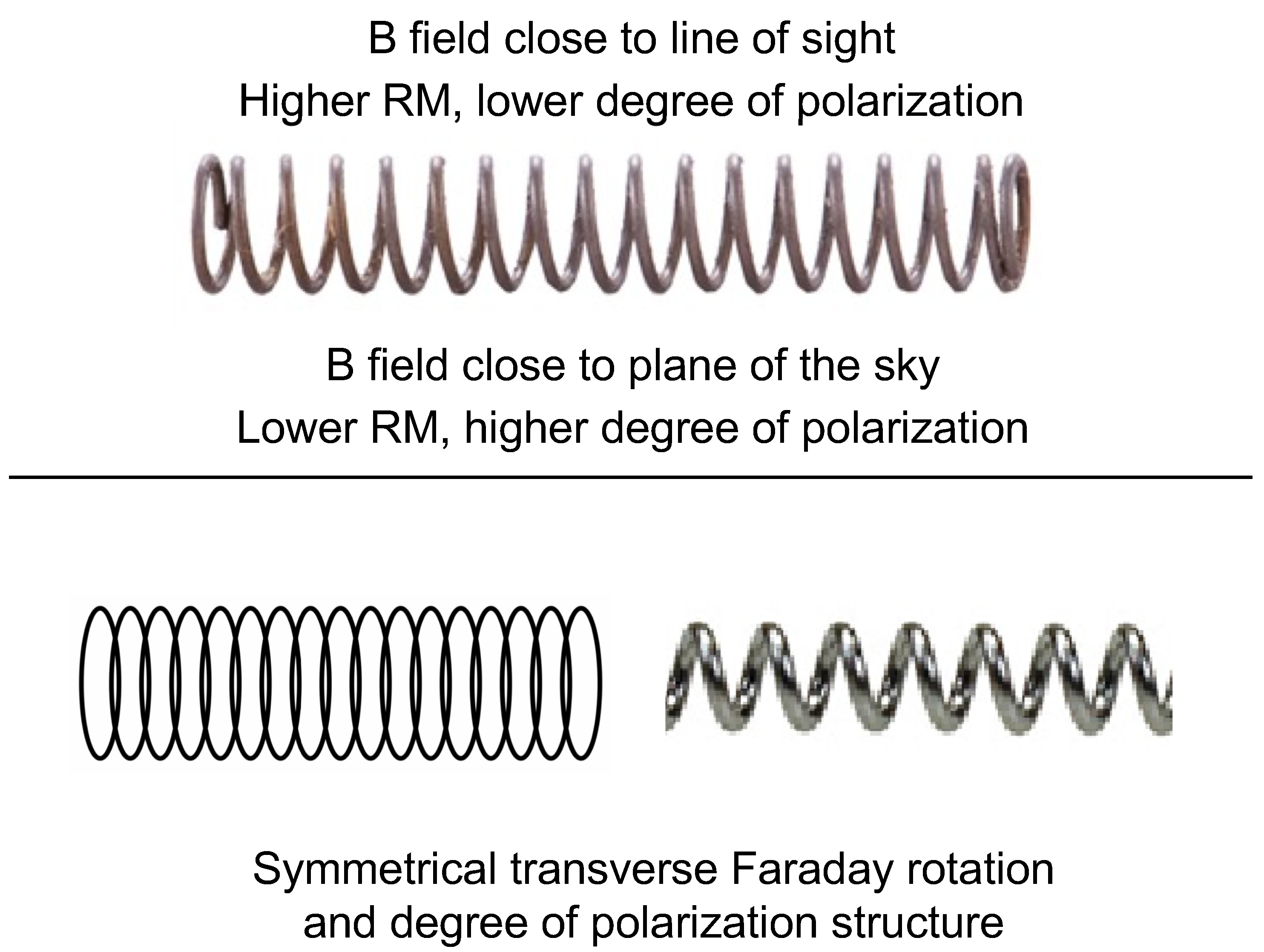

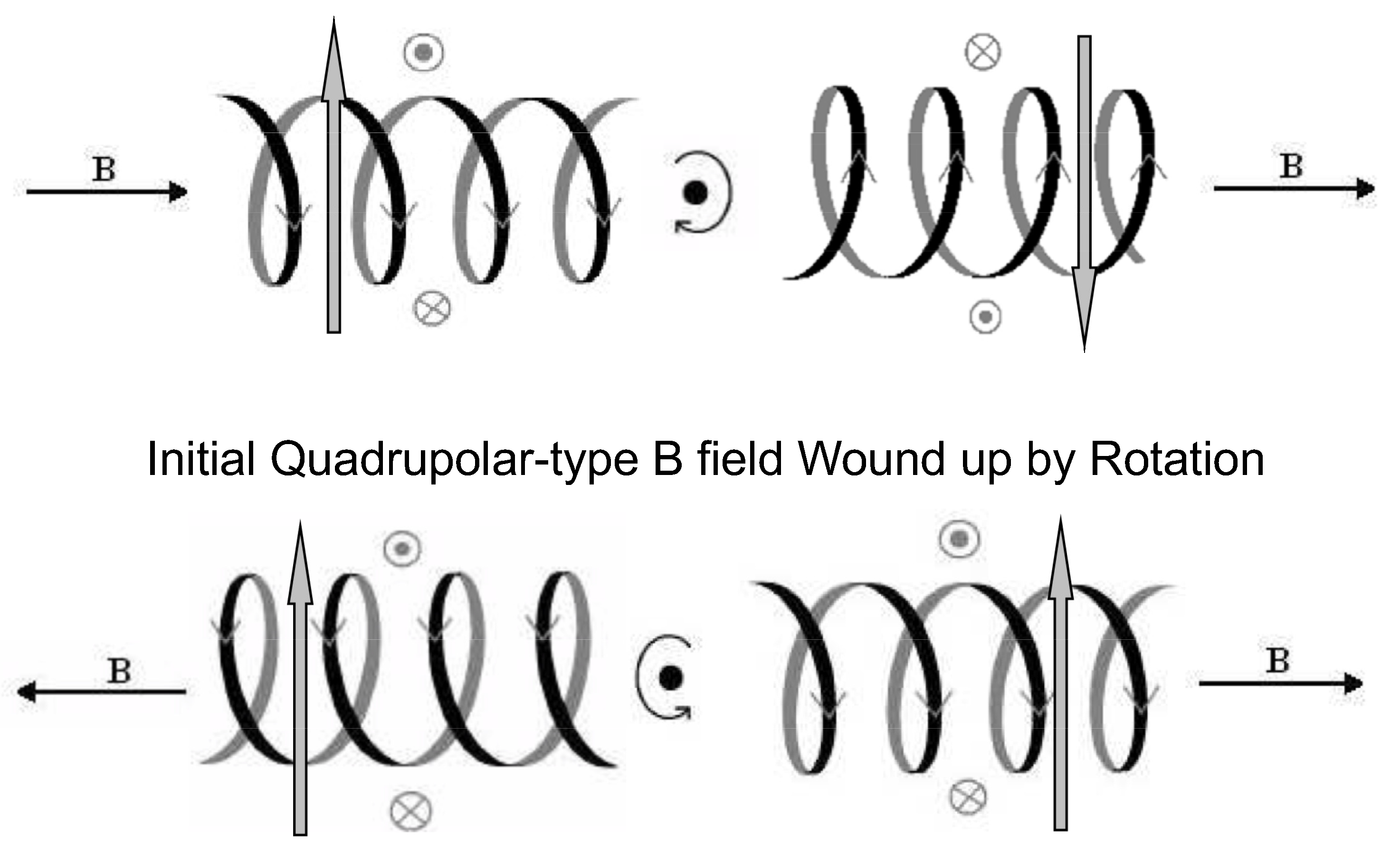
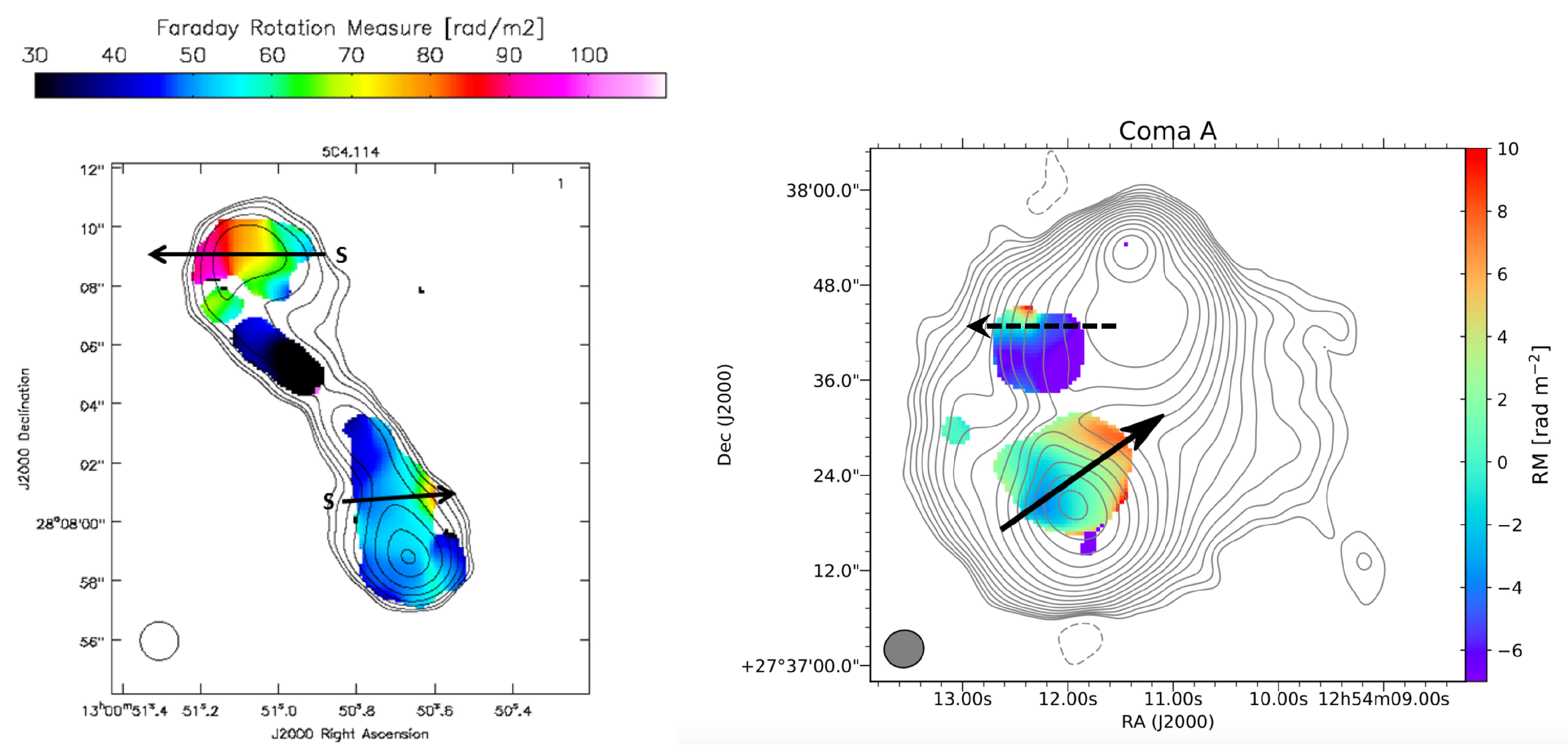

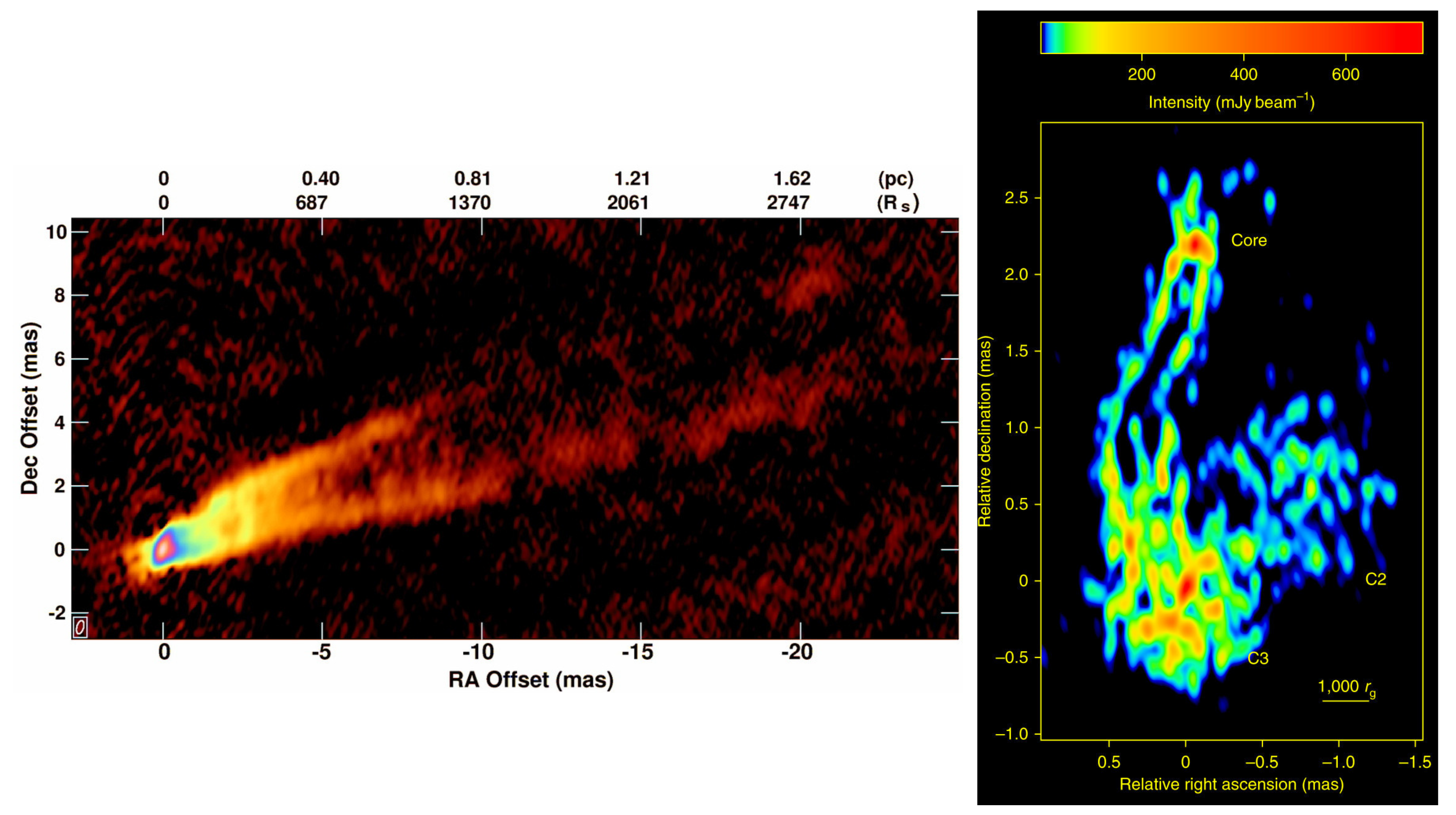
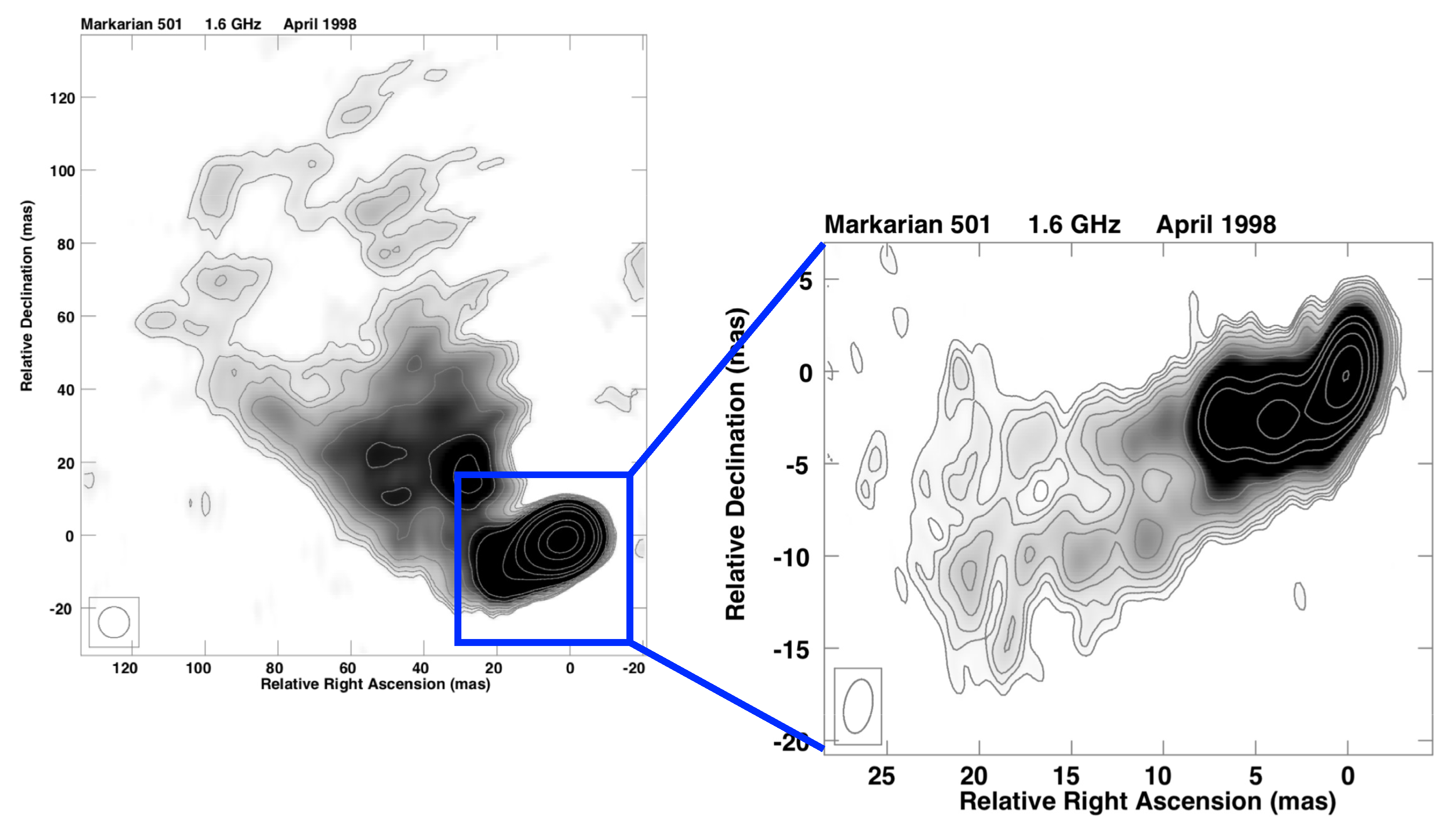

Publisher’s Note: MDPI stays neutral with regard to jurisdictional claims in published maps and institutional affiliations. |
© 2021 by the author. Licensee MDPI, Basel, Switzerland. This article is an open access article distributed under the terms and conditions of the Creative Commons Attribution (CC BY) license (https://creativecommons.org/licenses/by/4.0/).
Share and Cite
Gabuzda, D.C. Inherent and Local Magnetic Field Structures in Jets from Active Galactic Nuclei. Galaxies 2021, 9, 58. https://doi.org/10.3390/galaxies9030058
Gabuzda DC. Inherent and Local Magnetic Field Structures in Jets from Active Galactic Nuclei. Galaxies. 2021; 9(3):58. https://doi.org/10.3390/galaxies9030058
Chicago/Turabian StyleGabuzda, Denise C. 2021. "Inherent and Local Magnetic Field Structures in Jets from Active Galactic Nuclei" Galaxies 9, no. 3: 58. https://doi.org/10.3390/galaxies9030058
APA StyleGabuzda, D. C. (2021). Inherent and Local Magnetic Field Structures in Jets from Active Galactic Nuclei. Galaxies, 9(3), 58. https://doi.org/10.3390/galaxies9030058




